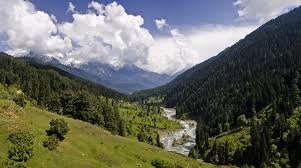Himachal Pradesh, a land of serene beauty and towering mountains, harbours a silent menace
beneath its picturesque landscapes – landslides. The Press Trust of India has reported that as
of this year, the state has experienced around six times more landslides than the last year, as
only 117 major landslides were witnessed in the entirety of 2022 compared to just 16 in 2020.
The consequences are dire; CM Sukhvinder stated that the losses amount to approximately Rs
10,000 crore, with a significant portion attributed to landslides since the beginning of the
monsoon in 2023.

Himachal’s History of Landslides
The history of landslides in Himachal is not a recent phenomenon. It dates back to the
infamous Snowdon landslide in Shimla in 1971. This catastrophic event demolished a
six-storey medical college, serving as an early warning about unchecked construction
practices in the region. The city of Shimla accommodates way more inhabitants than it was
originally designed for. Most of its buildings are perched precariously on slopes between 45
and 75 degrees, defying geologists’ recommendations for limited construction in such areas.
Another grim chapter unfolded in 1978 when landslides struck the Naina Devi range,
resulting from excessive rainfall. The roots of trees, a natural reinforcement for the soil, had
been weakened due to deforestation caused by road construction, a recurring issue in
Himachal. The National Institute of Disaster Management (NIDM) report then pointed out
that road construction often leads to deforestation and fissures in the slopes, further
increasing vulnerability to landslides.
The Kangra district, situated in the westernmost part of Himachal Pradesh, is no stranger to
natural disasters. Violations in multi-storey buildings, illegal extensions, and rampant
conversion of houses into hotels have exacerbated the risks in this fragile region.
What caused these landslides?
Experts cite several human-made factors behind the escalating landslides in Himachal.
Unscientific Constructions in the Himalayas
One of the primary reasons behind the escalating landslides in Himachal Pradesh is
unscientific construction practices in the Himalayan region. Geological experts point to
extensive hill slope cutting for construction and road widening, blasting for tunnels, and
hydroelectric projects as primary causes. The vertical cutting of mountains for road
construction with inadequate retaining walls has become a common sight in Himachal. Many
structures are erected without proper soil testing and engineering assessments. The desire for
panoramic views and commercial gains often overrides safety considerations.
Depletion of Forest Cover
Deforestation is another significant contributor to landslides in Himachal. Unscientific
constructions in the ecologically sensitive Himalayas, depletion of forest cover, and structures
near streams obstructing water flow are among the culprits. Trees play a vital role in
stabilising slopes by anchoring the soil with their root systems. When these trees are felled
for various reasons, including road construction and urban expansion, the hillsides lose their
natural reinforcement. As a result, the soil becomes more prone to erosion and landslides,
particularly during heavy rainfall.
Structures Near Streams
Construction near streams and rivers further exacerbates the landslide problem. Additionally,
improper drainage systems and intense rainfall further weaken slopes, making landslides
inevitable. Water bodies are natural drainage systems, carrying excess rainfall down the
slopes. When buildings encroach upon these areas, they obstruct the flow of water. This can
lead to an accumulation of water and increased pressure on the soil, ultimately triggering
landslides.
How do we fix this?
Addressing the landslide crisis in Himachal requires immediate and multifaceted solutions. A
2019 report by the National Disaster Management Authority (NDMA) highlighted the need
for better planning in hill states, population control, and stricter enforcement of norms.
This time around, as a response to the landslides, Chief Minister Sukhvinder Singh Sukhu
called for scientific and engineering solutions, urging experts to develop a holistic approach
to make Himachal risk resilient. Vulnerable areas, assessing risk factors, and considering
geological inputs were identified.
Promoting Responsible Tourism
Himachal’s booming tourism industry adds to the dilemma. While it brings economic
benefits, it also places immense pressure on the region’s fragile landscapes. To address this,
responsible tourism practices must be promoted. This involves limiting the construction of
large hotels and resorts in landslide-prone areas and encouraging sustainable tourism options
that minimise environmental impact.
Preserving Forest Cover
Conservation and restoration of forest cover are critical to mitigating landslides.
Reforestation efforts should focus on planting native species with strong root systems that
can help stabilise the soil. Additionally, strict regulations should be enforced to prevent
unauthorised tree felling and protect existing forests.
Enforcing Building Guidelines
Enforcing building guidelines that account for the unique challenges of Himachal’s terrain is
essential. These codes should restrict construction on steep slopes, mandate proper
foundation designs, and require the use of retaining walls where necessary. Regular
inspections and penalties for non-compliance can deter unsafe construction practices.
Himachal Pradesh requires a multifaceted approach that tackles the root causes of the issue.
By promoting responsible development, preserving the environment, and enforcing strict
regulations, Himachal Pradesh can work towards reducing the devastating impact of
landslides and ensuring the safety of its residents and visitors.
Finally, the landslides in Himachal Pradesh are not isolated incidents but symptoms of a
larger problem. The fragile Himalayan ecosystem, coupled with human-induced activities and
climate change has created this dangerous situation. To mitigate these risks, a concerted effort
involving scientific monitoring, sustainable development, and regional cooperation is
imperative. As we grapple with the devastating impact of landslides, it’s crucial to strike a
balance between harnessing the region’s resources and preserving its ecological integrity too.







